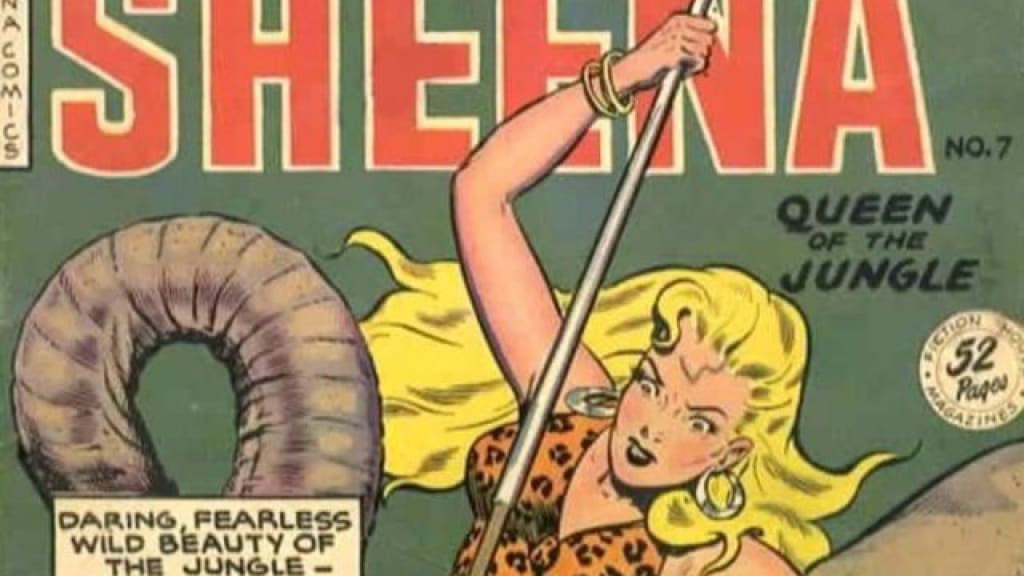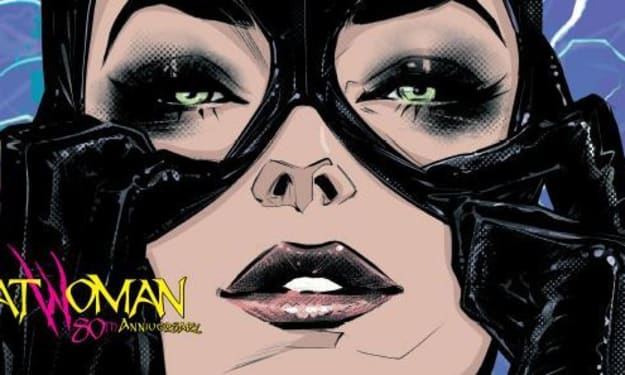1936-1938
Lady Comic Book History Podcast

Today we will be covering/discussing the first appearance of a solo female hero in a comic book, Sheena Queen of the Jungle as well as the other ladies of early comic books.
The first prominent female hero to be depicted in a comic book was Sheena, Queen of the Jungle. Published by Fiction House Primarily and created by Will Eisner and Jerry Iger, Sheena makes her debut in the first issue of Wags in 1937. She then was given her own 18 issue title in the spring of 1942 and concluded in Winter of 1952. The daughter of Cardwell Rivington, she goes with her father to explore Africa. Cardwell dies from accidentally drinking a magic potion made by Koba, a native witch doctor. Koba raises her as his own where she basically becomes the female version of Tarzan. She learned how to survive, learns to communicate with animals and is fluent in fighting with knives, spears, bows and makeshift weapons. It was with Sheena’s creation that the comic book world saw men’s exotic and erotic desires depicted on the page. Clothed in a leopard print dress, Sheena stood blonde and filled out with curves that could only exist in fiction. And because of course a woman can not truly stand on her own, at least not in the comic tales told in 1938 Sheena meets Bob Reynolds, an engineer that comes to Africa to work on an oil project. Sheena saves his life and soon after takes him and his team prisoner. Though Sheena was tightly clad in sexy, jungle worn outfits she was the basis for all the female heroes that would come after her. I referred to her as the female Tarzan, well this was further supported in Jumbo Comics #10 when Sheena goes head to head with Namu, a lion, whom she defeats with nothing but her own strength and a dagger. Sheena’s other victories are exerted over ivory and treasure hunters and wild beasts, where she exhibits her savage nature and desire to keep her title as Queen of the Jungle. Though Sheena was a step forward for feminists, she was only a small step forward, for white feminists. She did consider it her duty to protect the people of the Jungle, the black natives who were depicted as nothing more than savages. Her stories and representation simply reinforced the concept that it was the duty of the rational, white hero to look over her black underlings. As times when on Sheena’s stories changed with what was going on in the world, with her even cracking some Nazi skulls come the 40s. But she never stepped out of her stronghold, she did what she could from the safety of the Jungle. Sheena also challenged the traditional gender roles of the time, while living with Bob in her tree house it was clear that she was the strong half of the relationship, the provider whereas Bob was always the damsel in need of saving. In a time where comics were mostly written and consumed by men this could be off-putting especially considering the time but what was also depicted was Sheena’s desire to be open and animalistic in the expression of her sexuality. Crude and revealing drawings in congruence with suggested and at times explicit sexual content seemed to balance out any emasculating qualities that Sheena possessed.
Considering that Sheena was the start of comics for women, pre-dating even Superman in her first appearance I’d say that she was a pretty big step forward. Though it definitely solidified sexist, racist and classist themes, it reflected the times and gave comic book creators a stepping off point when creating strong women.
Now the first surge in creating women of consequence in the comic book medium was in 1940 totalling in 9 relevant heroes and 2 female heroes that have remained prominent, so let's take a journey into the 1940s
We start with ladies of upper class upbringings who want an escape from their daily lives so they take on personas of disguised crime fighters. Lady Luck created and designed by Will Eisner and Chuck Mazoujian started as a comic strip which was reprinted by Quality Comics in Smash Comics issues #42-85 which ran April of 1943-October of 1949. Lady Luck was cancelled and revived several times in her history, revived the first time in 2004 by Gary Chaloner and again in the New 52 DC Universe in March of 2013, debuting again in The Phantom Stranger #6 by Dan DiDio. Still in this category but with a little variation we have the Woman in Red who was created by Richard E. Hughes and George Mandel and made her debut in Thrilling Comics #2 In March of 1940 snf was published by Nedor Comics. The Woman in Red is the secret identity of policewoman Peggy Allen. She feels severely limited by her job so she creates a secret identity. She made regular appearances in Thrilling Comics but was never afforded her own cover appearance. She made her last Golden Age appearance in Thrilling comics #46 in February of 1945. Alan Moore revived the Woman in Red in Tom Strong issue #11 in 2001, she is revealed as a member of a superhero team that had been placed in suspended animation after an alien invasion in 1969. Previously without superpowers the Woman in Red came into possession of a ruby crystal sometime after WW2. The crystal granted her powers of flight, and energy projection prolonged exposure to said crystal eventually would turn her skin a shade of crimson. After her skin turns red her costume is changed from a head to toe leather costume to a one piece bathing suit. Because she of course had to be put in something more revealing to balance out the fact that she was one of the first female characters with superpowers. Speaking of superpowers our next hero is the Invisible Scarlet O’Niell, guess what her power is….created by Russell Stamm and making her first appearance on June 3rd of 1940 and published by the Chicago Daily Times the comic stril heroine was granted the power of invisibility when she stuck her finger in an invisibility ray her father was working on. She controlled the ability to appear and disappear by pressing a nerve in her wrist. Her comic strip ran through October 24th of 1954 before the strips title was renamed and her character was dropped. What we see from these women are people that feel trapped in their daily lives so they decide to become someone else, now whether the need to be something more is strictly my female interpretation or whether it was the actual intent is up for grabs but I choose to believe that these characters were a representation of real women who wanted more from their lives, of course this brings us back to the classist ideal that escapism through becoming a vigilante was a privilege that was reserved for upper-class white women.
On the opposite end of the spectrum we have the Red Tornado, published by DCs All American Comics #3 in June of 1939 and again in issue #20 in November of 1940 and created by Sheldon Mayer. Ma Hunkel, a stay at home mom appeared in a Scribbly story where Scribbly’s little brother and Ma’s daughter are kidnapped. Inspired by Scribbly’s love and admiration for the Green Lantern, Ma decides to don a costume and fight crime. By issue #23 the Red Tornado was sharing billing with Scribbly and in issue #24 Ma’s kids join her as the Cyclone Twins. The feature ran through All American Comics issues #59 1944. The character resurfaced in a 3-page Scribbly story in DC’s Secret Origins #29 in August of 1986. She was a supporting character of the Justice Society of America and appeared in an 80 page Giant #1 in Sept 1999 Way of the Amazon, one of the first all female focused stories also featuring Liberty Belle, Phantom Lady and Wonder Woman. In the original comic book story Ma Hunkel is a working mother whose costume consists of long johns and wearing a cooking pot on her head. She was often the butt of jokes referring to her as the Red Tomato due to her rounder build she is also defined as having surprising physical strength and here it is being a great cook. Now there are two possible interpretations to how her character is portrayed, the idealistic one is that women like Ma Hunkel, women that are housewives and mothers are the real heroes, however as a reflection of the times the more realistic interpretation is that women like Ma Hunkel, women that are housewives and mothers should stay at home. That their place is in the kitchen, The Red Tornado was too often the butt of jokes and storylines that involved endinging like her pants ripping for the idealistic interpretation to be taken as true.
Before we move into the first truly powerful female hero we have to touch base with one more jungle girl. Last week we talked about Sheena Queen of the Jungle, and today we have Fantomah, published by Fiction House and making her first appearance in Jungle Comics #2 in February of 1940 and created by Fletcher Hanks she acted as a backup feature until her final appearance in Issue #51 in March of 1944. Starting off as a jungle girl, her origin was retconned in her third iteration as an ancient egyptian princess who was revived to protect the jungle. Unlike Sheena this jungle girl did have superpowers, and whenever she cast a spell her face would change from a normal human woman to a blue-skinned skull like image. She also had the ability to fly, transform objects into different objects and levitate other objects and cause humans to mutate into other forms. The change in her face when her true power comes out does nothing other then set the trend in the comic book world, that women that possess true power are inhuman and somehow that power is tied to their morality.
Also in 1940 we have Black Widow and when I say that I am not talking about Natasha Romanoff, this is not the Black Widow that you know. Still published by Marvel comics which was at the time called Timely Comics the original Black Widow made her first appearance in Mystic Comics #4, created by George Kapitan and Harry Sahle Madam Claire Voyant was known as the “strangest, most terrifying character in action picture magazines - a tool for Satan whose very touch means death”. Claire is a spirit medium who communicates with the dead through supernatural means, during one of her meeting with the passed she is possessed by Satan, under the influence of possession she is forced to put a curse on the family she is working for, a family that soon dies in a car accident the lone survivor of the car accident kills Claire in revenge. After her death Voyant’s soul is sent to hell where Satan dresses her in a Black Widow costume and grants her the power to kill with a single touch of her fingers on one's head. She uses this new ability to kill arms manufacturers, crime bosses and members of a sydicate called Murder Unlimited. The character trait that stuck with the Black Widow through her Golden Age appearances was that she shows no mercy or hesitation or remorse in killing her victims. Killing victims with a single touch is already a pretty significant power but Miss Clair Voyant also possessed superhuman strength, enhanced endurance, flight, teleportation, mental suggestion, invisibility, appearance alteration, immortality, ability to speak to the dead, and the ability to mystically regenerate or heal others. We see in her and in our final hero the beginnings of what an Overpowered hero looks like. Black Widow was comic books first costumed and superpowered female character.
Lastly we have Marvel Comics Thena, created by Martin A Burnstein and Jack Kirby she made her first appearance in Red Raven Comics #1 in August of 1940 she was created as the Eternal counterpart to Athena to seal a treaty between the Olympian Gods and the Eternals and Thena was Athena’s personal representative on Earth. Thena’s main love interest was Kro, who had a chance to kill her but made a different call, the two fall in love and have twins who they gave to a mortal woman to raise as her own. She eventually had to battle her charge Athena after becoming an ally of Thor, she fought alongside the Avengers to defeat Maelstrom and she was the lone Eternal to stay on earth, later fighting alongside the West Coast Avengers. She possessed superhuman speed, strength, durability, regeneration, energy blasts, flight, illusion generation, matter transmutation, mind control, telekinesis, telepathy, and teleportation. In the 2006 reboot of Thena she is left without her memories and is married with a son working as a researcher for Stark Enterprises, but after suffering nightmares where she was immortal she awoke having gained back her costume and powers. And with Thena we see the beginning of overpowered women being imbued with mostly mental powers which I will do a deep dive into but she is our first female hero with telepathic abilities.
The bulk of 1940 was a slate of mostly forgettable female heroes, stories and characters that highlighted classist differences as well as the notion that powerful women must be heartless and devoid of compassion as is the case with the Black Widow. The two more enduring women created in this time period warranted their own article so next time I will be talking about Hawkgirl and Catwoman. Characters that highlight the rampant sexism that is ingrained in the creation of female heroes in a way that we have not analyzed yet.
About the Creator
Alexandrea Callaghan
Certified nerd, super geek and very proud fangirl.






Comments
There are no comments for this story
Be the first to respond and start the conversation.